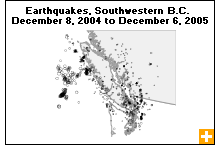Common menu bar links
Earthquakes and tsunamis
Archived Content
Information identified as archived is provided for reference, research or recordkeeping purposes. It is not subject to the Government of Canada Web Standards and has not been altered or updated since it was archived. Please contact us to request a format other than those available.
Canada has a long history of seismic disruptions.We know this from the geological record and from stories of flood and destruction told by the Nuu-chah-nulth (or Nootka) on the West Coast. Scientists have a good idea where earthquakes are likely to occur, but they cannot yet pinpoint with accuracy when the next one will occur.
Earthquakes happen when there is sudden movement along a break or fault within the earth's crust. Thousands of earthquakes take place each year in Canada, mostly along the West Coast, in Yukon, in the high Arctic, and along the eastern seaboard. In the rest of the country, earthquakes are rare but not unheard of.
 Despite
the enormous forces involved when two tectonic plates grind against,
over or across each other, most earthquakes are only detectable using
seismic equipment. With this information, seismologists have built
up a picture of Canada that shows the pattern and magnitude of seismic
events. Such accurate and reliable seismic information coupled with
demographic data gives decision makers an important tool for risk
assessment and city planning.
Despite
the enormous forces involved when two tectonic plates grind against,
over or across each other, most earthquakes are only detectable using
seismic equipment. With this information, seismologists have built
up a picture of Canada that shows the pattern and magnitude of seismic
events. Such accurate and reliable seismic information coupled with
demographic data gives decision makers an important tool for risk
assessment and city planning.
An earthquake centred on the ocean floor sometimes has the potential to cause a tsunami. Few are of the megathrust variety that started the tsunami that hit Vancouver Island in 1964. Moving at speeds of over 700 kilometres per hour, the waves piled into the funnel-like opening of Alberni Inlet. Within minutes the huge waves travelled inland to the town of Port Alberni. Surprisingly, there were no deaths, but dozens of homes, buildings and vehicles were damaged or destroyed by waves three metres above the high tide mark. Fortunately, tsunamis have so far occurred only rarely in Canada.


